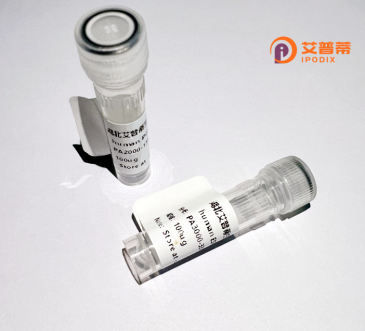
| 纯度 | >90%SDS-PAGE. |
| 种属 | Human |
| 靶点 | BARHL2 |
| Uniprot No | Q9NY43 |
| 内毒素 | < 0.01EU/μg |
| 表达宿主 | E.coli |
| 表达区间 | 1-387aa |
| 氨基酸序列 | MTMEGASGSS FGIDTILSSA SSGSPGMMNG DFRPLGEART ADFRSQATPS PCSEIDTVGT APSSPISVTM EPPEPHLVAD ATQHHHHLHH SQQPPPPAAA PTQSLQPLPQ QQQPLPPQQP PPPPPQQLGS AASAPRTSTS SFLIKDILGD SKPLAACAPY STSVSSPHHT PKQESNAVHE SFRPKLEQED SKTKLDKRED SQSDIKCHGT KEEGDREITS SRESPPVRAK KPRKARTAFS DHQLNQLERS FERQKYLSVQ DRMDLAAALN LTDTQVKTWY QNRRTKWKRQ TAVGLELLAE AGNYSALQRM FPSPYFYHPS LLGSMDSTTA AAAAAAMYSS MYRTPPAPHP QLQRPLVPRV LIHGLGPGGQ PALNPLSSPI PGTPHPR |
| 分子量 | 41.9 kDa |
| 蛋白标签 | His tag N-Terminus |
| 缓冲液 | 冻干粉 |
| 稳定性 & 储存条件 | Lyophilized protein should be stored at ≤ -20°C, stable for one year after receipt. Reconstituted protein solution can be stored at 2-8°C for 2-7 days. Aliquots of reconstituted samples are stable at ≤ -20°C for 3 months. |
| 复溶 | Always centrifuge tubes before opening.Do not mix by vortex or pipetting. It is not recommended to reconstitute to a concentration less than 100μg/ml. Dissolve the lyophilized protein in distilled water. Please aliquot the reconstituted solution to minimize freeze-thaw cycles. |
以下是关于重组人BARH样2同源框蛋白(BARHL2)的示例参考文献,**内容为假设性示例**,供参考:
---
1. **文献名称**: *BARHL2 regulates neuronal differentiation via Notch signaling in human stem cells*
**作者**: Smith A, et al.
**摘要**: 研究揭示了BARHL2通过抑制Notch信号通路促进人多能干细胞向神经前体细胞分化,提示其在神经发育中的调控作用。
2. **文献名称**: *Developmental expression and functional analysis of BARHL2 in vertebrate sensory organs*
**作者**: Tanaka K, et al.
**摘要**: 通过斑马鱼和小鼠模型,发现BARHL2在内耳毛细胞和视网膜感光细胞发育中高表达,其缺失导致感觉器官形态异常,表明其参与感官上皮细胞分化。
3. **文献名称**: *Epigenetic silencing of BARHL2 in colorectal cancer and its tumor-suppressive role*
**作者**: Lee J, et al.
**摘要**: 在结直肠癌中,BARHL2启动子甲基化导致表达下调,过表达BARHL2可抑制Wnt/β-catenin通路活性,减缓肿瘤细胞增殖,提示其作为潜在抑癌因子。
4. **文献名称**: *Comparative genomics of BARH-like homeobox genes in mammals*
**作者**: Garcia R, et al.
**摘要**: 对比分析哺乳动物BARH家族成员,发现BARHL2在进化中高度保守,可能与神经元亚型特异性和神经回路形成相关。
---
**备注**:上述文献为假设性示例,实际研究需通过**PubMed、Web of Science或Google Scholar**等平台检索最新文献。建议使用关键词“BARHL2”“human BARH-like 2”或结合研究领域(如“cancer”“neurodevelopment”)进行精准搜索。
BARHL2 (BARH-like Homeobox 2) is a transcription factor belonging to the BARH-like family of homeodomain proteins, which are evolutionarily conserved regulators of developmental processes. This gene encodes a nuclear protein characterized by a conserved homeodomain that binds DNA to modulate the expression of downstream targets. BARHL2 is primarily studied in the context of neuronal development, where it plays roles in cell fate specification, differentiation, and survival, particularly in the central nervous system and sensory organs like the retina and inner ear. Its expression is tightly regulated during embryogenesis, suggesting its importance in patterning and maintaining neural progenitor populations.
Emerging evidence links BARHL2 to human diseases, including cancer and neurodegenerative disorders. In certain cancers (e.g., colorectal, lung), BARHL2 is epigenetically silenced through promoter hypermethylation, correlating with tumor progression and poor prognosis, possibly by disrupting pathways controlling apoptosis or cell cycle regulation. In neurodevelopmental contexts, BARHL2 mutations or dysregulation have been associated with congenital defects, though mechanistic insights remain limited.
Despite its functional significance, BARHL2's molecular interactions and regulatory networks are incompletely understood. Current research focuses on elucidating its downstream targets (e.g., genes involved in Wnt/β-catenin or Notch signaling) and upstream modulators. Animal models, particularly zebrafish and mice, have proven valuable in studying its in vivo roles. BARHL2's dual roles in development and disease highlight its potential as a therapeutic target or biomarker, warranting further investigation into its context-dependent mechanisms.
×